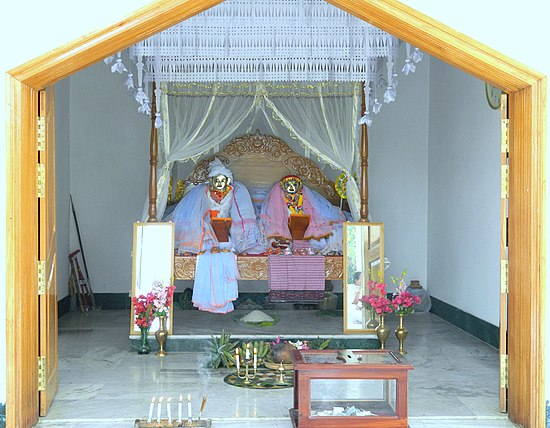Lairembi
Lairembi (/ˈlaɪræmbi/; Old Manipuri: Lailempi) or Lairemma (/ˈlaɪræmmə/; Old Manipuri: Lailemma), is the Meitei word for 'goddess' or 'female deity',[1][2] the male form is "Lairemba". It is a female term for a deity in Sanamahism (Meitei religion).[1][2][3]

The idea and reverence for the goddesses appears in the Puya (Meitei texts).
Examples
changeImoinu
changeImoinu is the Meitei goddess of wealth, prosperity, hearth fire and family. She lives either in the kitchen or the Sanamahi Kachin.[4][5]
Leimarel Sidabi
changeLeimarel Sidabi is the highest female divinity in Meitei religion. She is the highest mother earth goddess as well as the wife of Atingkok, the supreme creator god.[6][7][8]
Nongthang Leima
changeNongthang Leima (Meitei: ꯅꯣꯡꯊꯥꯡ ꯂꯩꯃ) is the goddess of using sex and beauty, thunder and lightning.[9][10][11][12] Created by Atingkok (or Salailen) to attract Haraba (Pakhangba),[11][13][14] she is the mistress of thunder and lightning in the chaos in the early world. She is also the predictor of the first rain.[15] She is known for limiting the chaos and permitting the creation.[16]
Panthoibi
changePanthoibi is the Meitei goddess of war, love and fertility. She is the mother goddess in Sanamahism (Meitei religion) and she has many faces.[17][18]
Phouoibi
changePhouoibi (Phouoipi) or 'Phouleima (Phoureima) is the goddess of the agriculture, crops, fertility, grains, harvest, paddy, rice and wealth.[19][20][21][22] She fell in love with Akongjamba[23] but fate doesn't permit her love to be fulfilled. So, Phouoibi and Akongjamba took rebirth.[20][22]
Yumjao Leima
changeYumjao Leima (Old Manipuri: Yumchao Leima) or Yumjao Lairembi (Old Manipuri: Yumchao Lailempi) or Yumjao Lairemma (Old Manipuri: Yumchao Lailemma) is the mother goddess of house, household, royalty, rule and power.[24][25][26][27] Being the all time ruling Queen Mother,[28] she assumes a human form in white clothes and blesses kings.[29]
Related pages
changeReferences
change- ↑ 1.0 1.1 Indian Anthropologist: Journal of the Indian Anthropological Association. Indian Anthropological Association. 2008.
- ↑ 2.0 2.1 Doshi, Saryu (1989). Dances of Manipur: The Classical Tradition. Marg Publications. ISBN 978-81-85026-09-1.
- ↑ Parratt, Saroj Nalini (1997). The Pleasing of the Gods: Meitei Lai Haraoba. Vikas Publishing House. pp. 3, 25. ISBN 978-81-259-0416-8.
- ↑ "A Hymn for Goddess Emoinu". e-pao.net.
- ↑ "emoinu". e-pao.net.
- ↑ Meitei, Sanjenbam Yaiphaba; Chaudhuri, Sarit K.; Arunkumar, M. C. (2020-11-25). The Cultural Heritage of Manipur. Routledge. p. 221. ISBN 978-1-000-29637-2.
- ↑ Karna, Mahendra Narain (1998). Social Movements in North-East India. Indus Publishing. p. 200. ISBN 978-81-7387-083-5.
- ↑ Devi, Dr Yumlembam Gopi. Glimpses of Manipuri Culture. Lulu.com. p. 23. ISBN 978-0-359-72919-7.
- ↑ Singh, L. Bhagyachandra (1991). A Critical Study Of The Religious Philosophy. p. 51.
- ↑ Moirangthem Kirti (1993). Folk Culture of Manipur. Manas Publications. ISBN 978-81-7049-063-0.
- ↑ 11.0 11.1 Folk-lore. Indian Publications. 1991.
- ↑ The Anthropologist: International Journal of Contemporary and Applied Studies of Man. Kamla-Raj Enterprises. 2003.
- ↑ Session, North East India History Association (1995). Proceedings of North East India History Association. The Association.
- ↑ "Incarnations of Goddess Nongthang Leima By James Oinam". www.e-pao.net. Retrieved 2022-03-15.
- ↑ Koenraad Elst (2002). Who is a Hindu? Hindu Revivalist Views of Animism, Buddhism, Sikhism and Other Offshoots of Hinduism. p. 165.
- ↑ Rao, Nitya; Rürup, Luise (1997). A Just Right: Women's Ownership of Natural Resources and Livelihood Security. Friedrich Ebert Stiftung. p. 175. ISBN 978-81-7440-044-4.
- ↑ Jain, Jyotindra (1998). Other Masters: Five Contemporary Folk and Tribal Artists of India. Crafts Museum and the Handicrafts and Handlooms Exports Corporation of India.
- ↑ Parratt, Saroj Nalini (1997). The Pleasing of the Gods: Meitei Lai Haraoba. Vikas Publishing House. pp. 8, 9, 119. ISBN 978-81-259-0416-8.
- ↑ Paniker, K. Ayyappa (1997). Medieval Indian Literature: Surveys and selections. Sahitya Akademi. ISBN 978-81-260-0365-5.
- ↑ 20.0 20.1 Devi, Lairenlakpam Bino (2002). The Lois of Manipur: Andro, Khurkhul, Phayeng and Sekmai. Mittal Publications. ISBN 978-81-7099-849-5.
- ↑ Sanajaoba, Naorem (1993). Manipur: Treatise & Documents. Mittal Publications. ISBN 978-81-7099-399-5.
- ↑ 22.0 22.1 Meitei, Sanjenbam Yaiphaba; Chaudhuri, Sarit K.; Arunkumar, M. C. (2020-11-25). The Cultural Heritage of Manipur. Routledge. ISBN 978-1-000-29637-2.
- ↑ Oinam, Bhagat; Sadokpam, Dhiren A. (2018-05-11). Northeast India: A Reader. Taylor & Francis. ISBN 978-0-429-95320-0.
- ↑ Muthukumaraswamy, M. D.; Kaushal, Molly (2004). Folklore, Public Sphere, and Civil Society. NFSC www.indianfolklore.org. ISBN 978-81-901481-4-6.
- ↑ Chaki-Sircar, Manjusri (1984). Feminism in a Traditional Society: Women of the Manipur Valley. Shakti Books. ISBN 978-0-7069-1967-7.
- ↑ Birajit, Soibam (2014-12-01). Meeyamgi Kholao: Sprout of Consciousness. ARECOM ( Advanced Research Consortium, Manipur). p. 135.
- ↑ Rao, Nitya; Rürup, Luise (1997). A Just Right: Women's Ownership of Natural Resources and Livelihood Security. Friedrich Ebert Stiftung. ISBN 978-81-7440-044-4.
- ↑ Birajit, Soibam (2014-12-01). Meeyamgi Kholao: Sprout of Consciousness. ARECOM ( Advanced Research Consortium, Manipur). p. 136.
- ↑ George, K. M. (1992). Modern Indian Literature, an Anthology: Plays and prose. Sahitya Akademi. ISBN 978-81-7201-783-5.